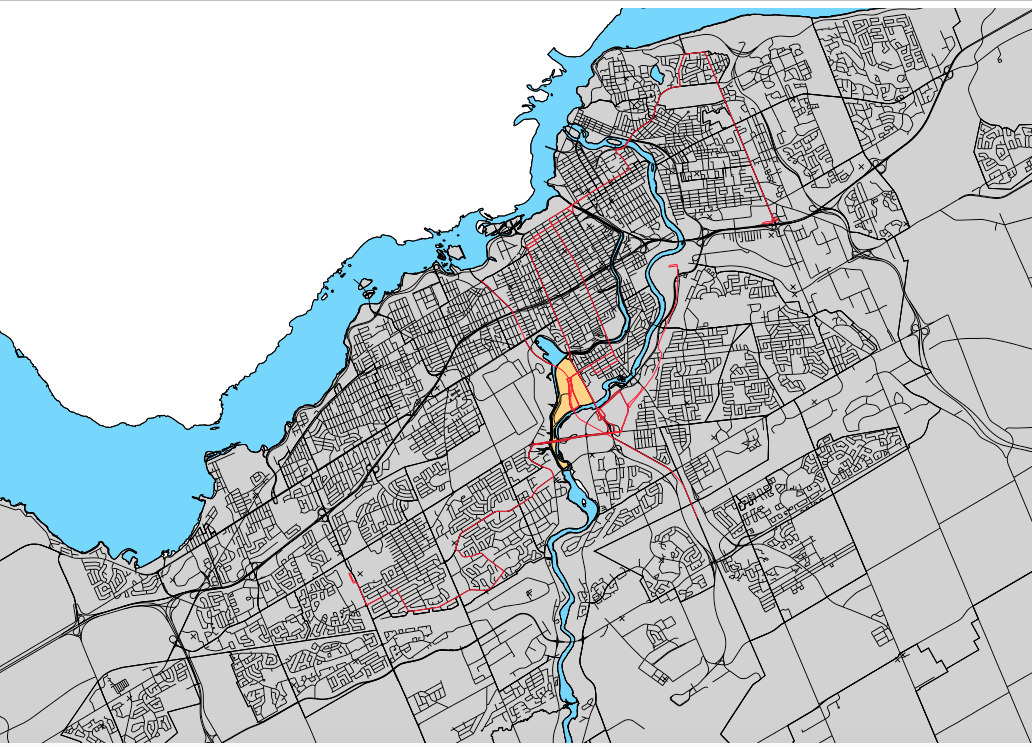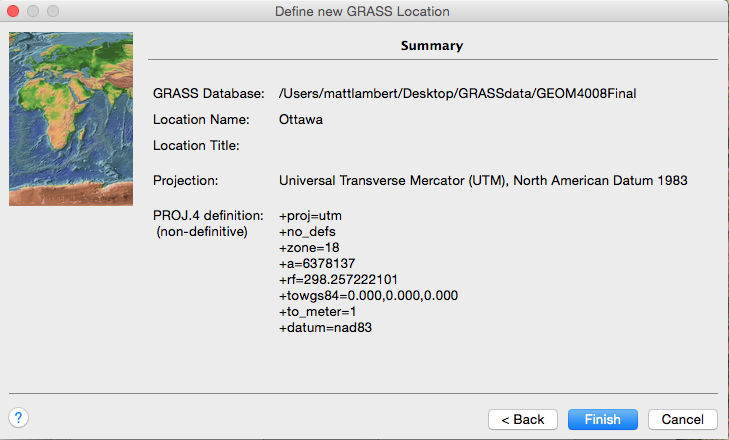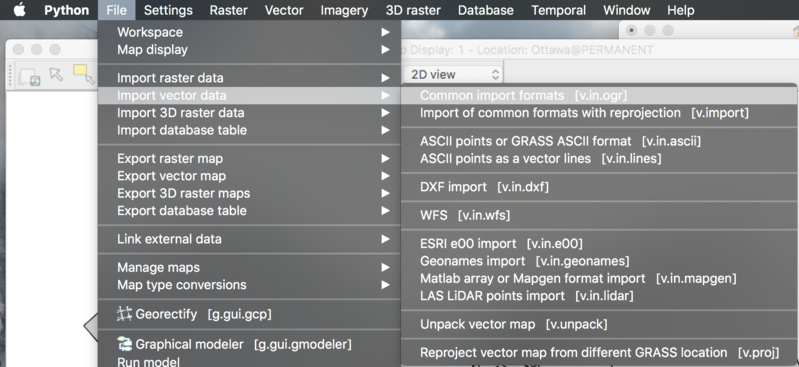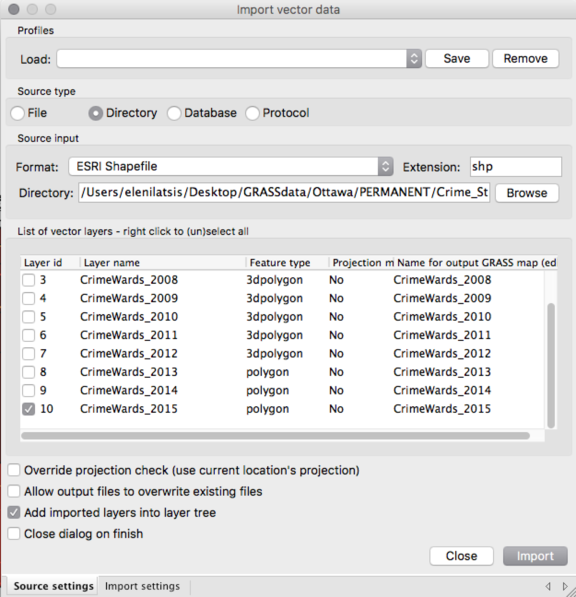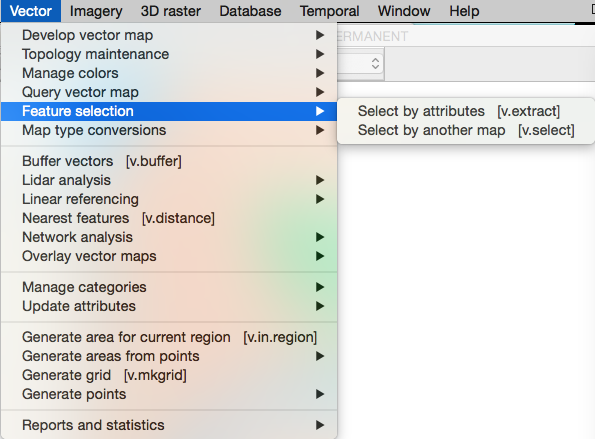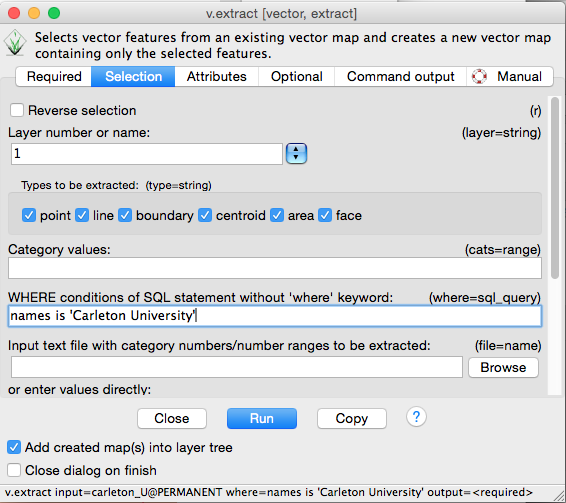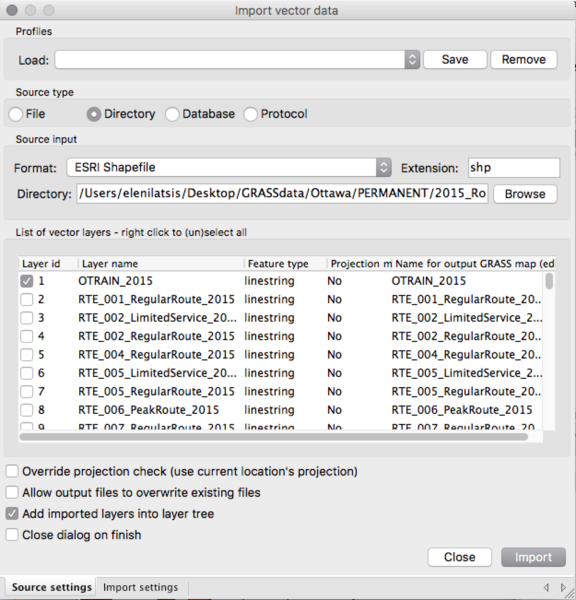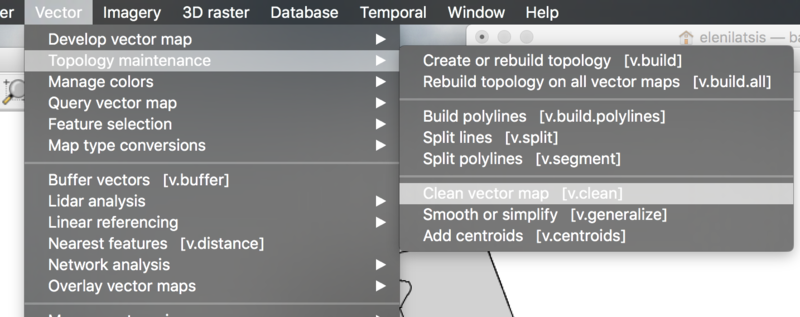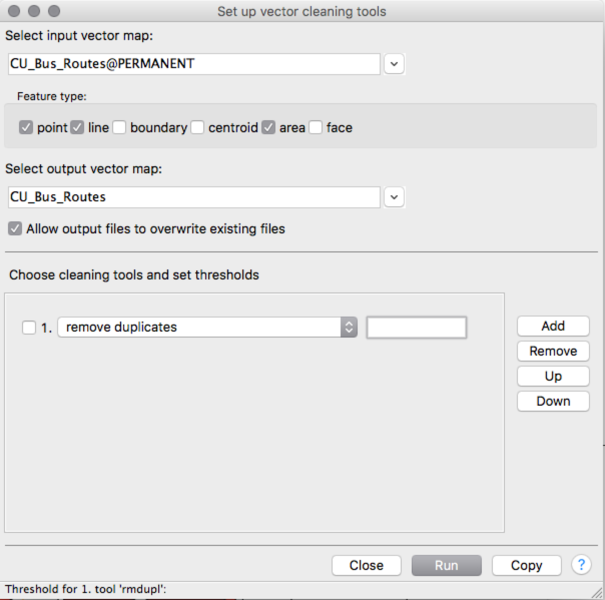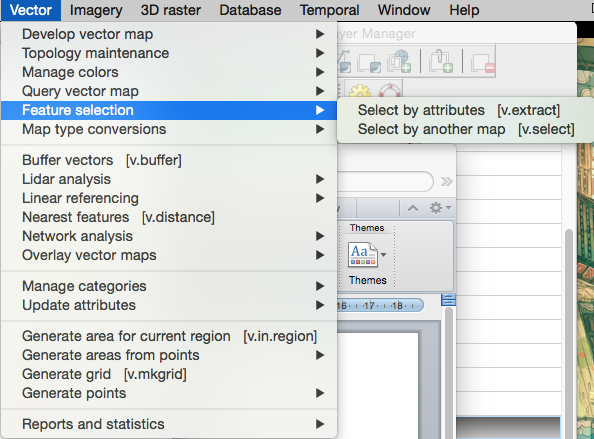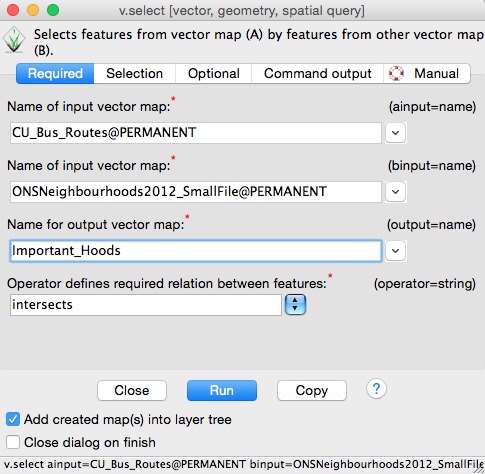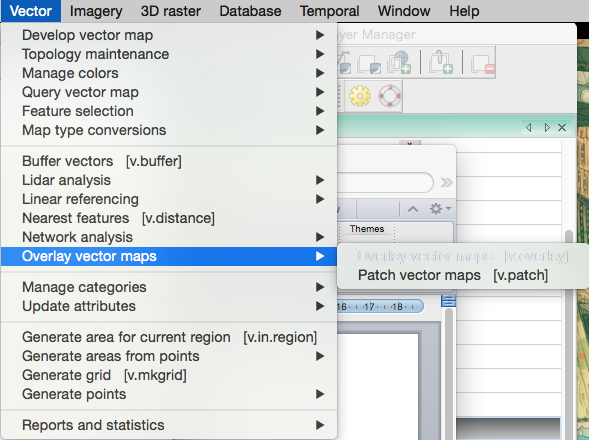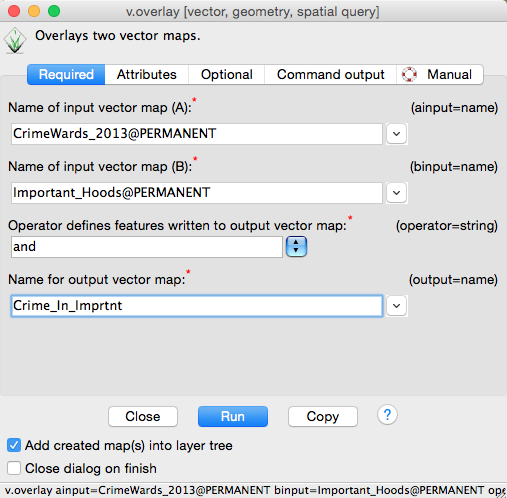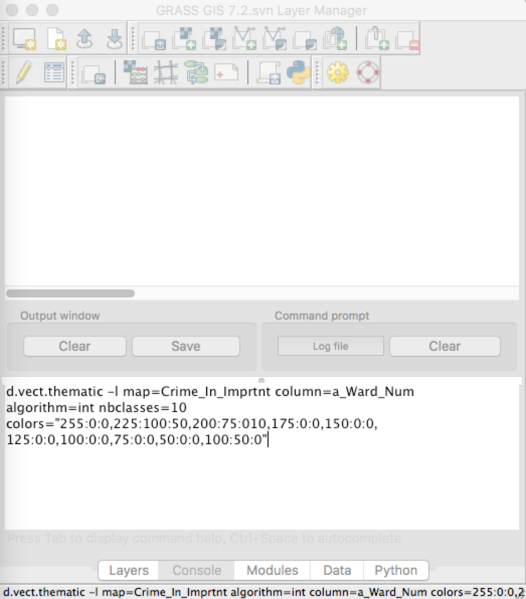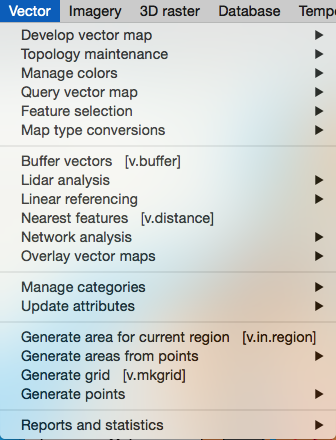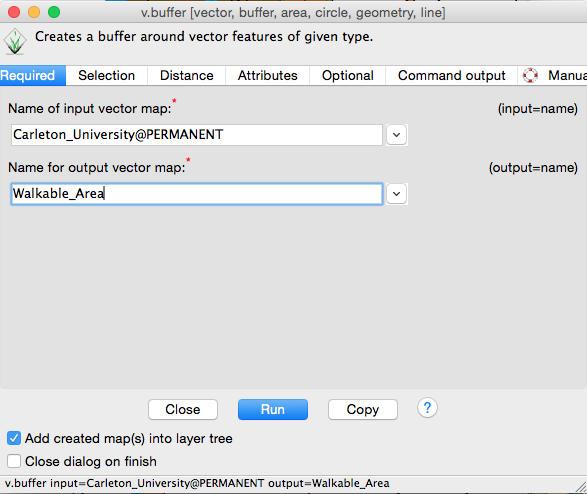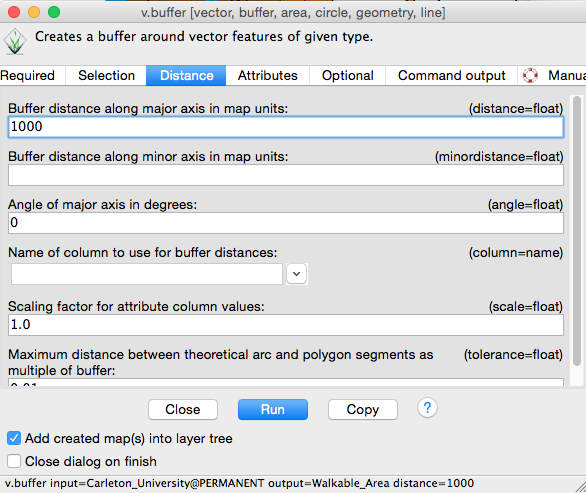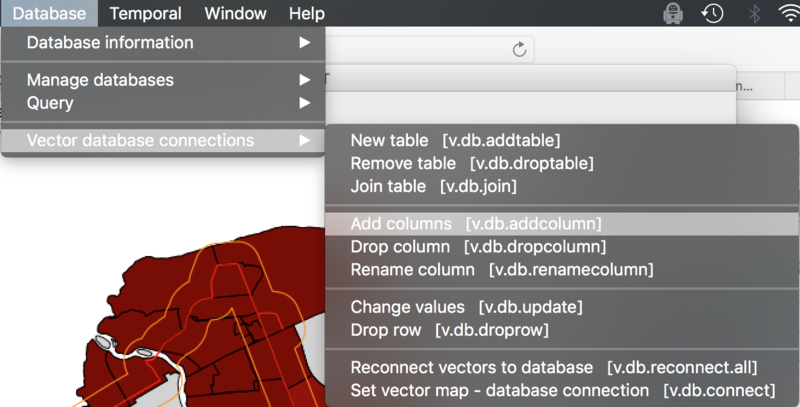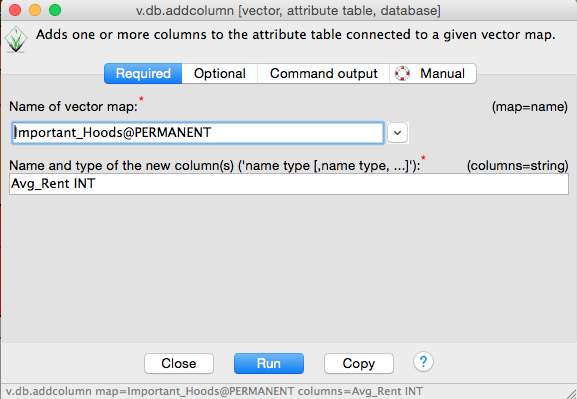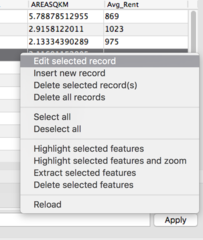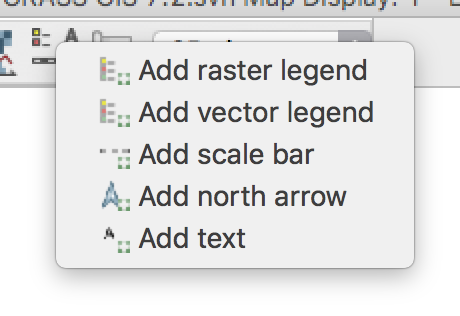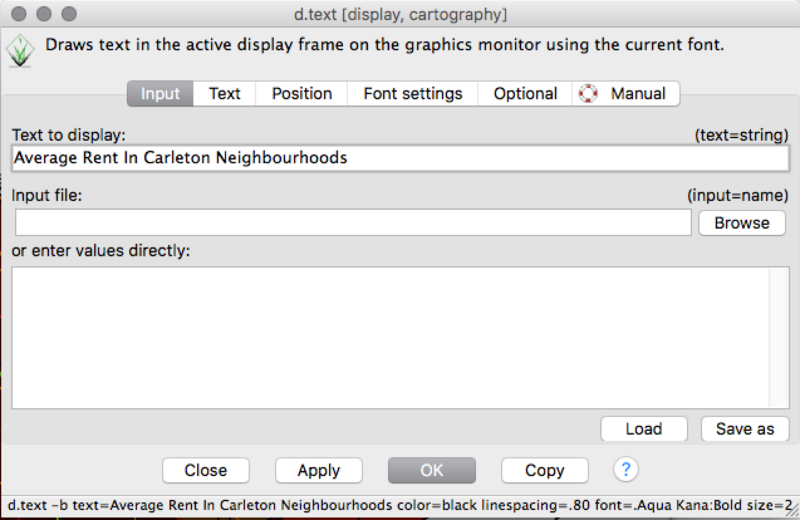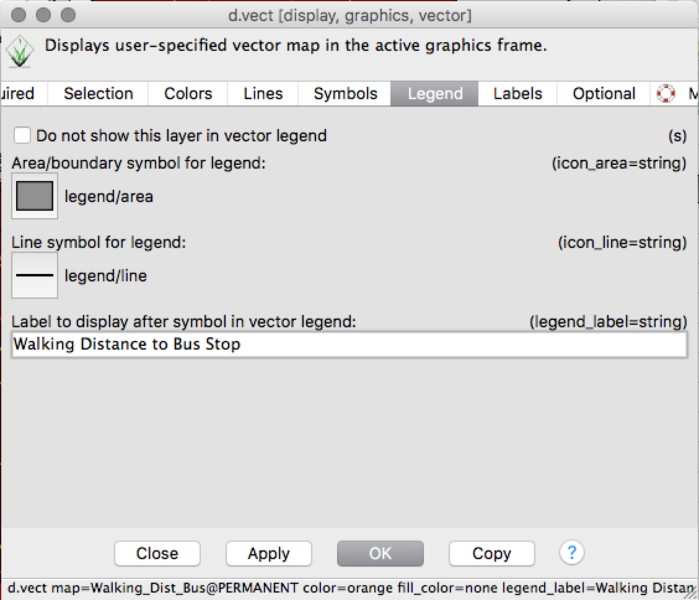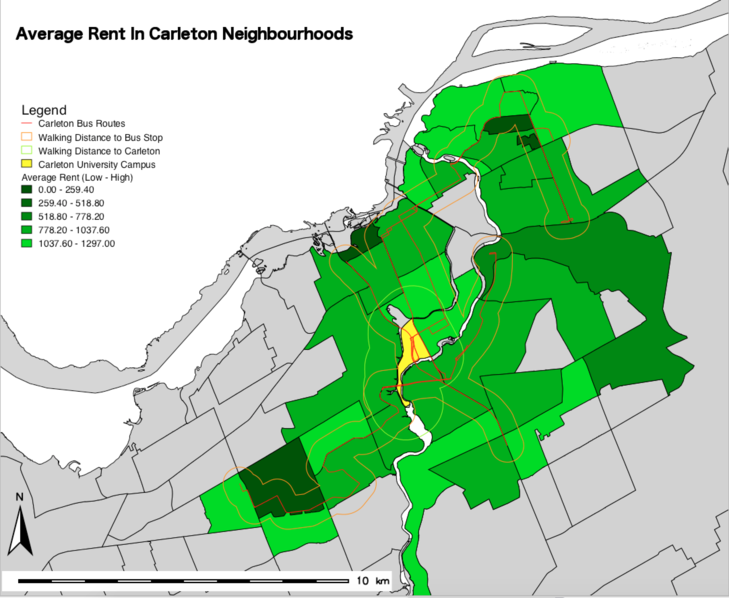Difference between revisions of "Thematic Mapping using GrassGIS"
Elenilatsis (talk | contribs) |
|||
| (45 intermediate revisions by 2 users not shown) | |||
| Line 3: | Line 3: | ||
The purpose of this tutorial will be to use multiple tools in [https://grass.osgeo.org Grass GIS] that will manipulate vector data. The example to be used in the tutorial will be the analysis of Ottawa City neighbourhoods to determine where would be the most appropriate place to live as a student attending Carleton University. This tutorial will use the following tools: |
The purpose of this tutorial will be to use multiple tools in [https://grass.osgeo.org Grass GIS] that will manipulate vector data. The example to be used in the tutorial will be the analysis of Ottawa City neighbourhoods to determine where would be the most appropriate place to live as a student attending Carleton University. This tutorial will use the following tools: |
||
| − | '''Extract'''- selection by attributes, '''Patch'''- patch vector layers together, '''Select'''- selection by location, |
+ | '''Extract'''- selection by attributes, '''Patch'''- patch vector layers together, '''Select'''- selection by location, '''Clean vector map''' to remove any duplicates, '''Overlay'''- clip tool, '''Buffer'''- generate buffer and '''Add thematic (choropleth) vector map layer''' to create two different thematic maps. |
| ⚫ | |||
| − | '''Overlay'''- clip tool, and '''Buffer'''- generate buffer |
||
| − | |||
| ⚫ | |||
''This is a basic introduction to thematic mapping using the Grass GIS software vector analysis capabilities.'' |
''This is a basic introduction to thematic mapping using the Grass GIS software vector analysis capabilities.'' |
||
== Introduction == |
== Introduction == |
||
| − | The purpose of this tutorial is to show how to represent and visually understand spatial vector data using thematic mapping. This tutorial addresses a problem that many individuals have when looking for new housing. The issue is of finding the most appropriate area to live in based on a multitude of factors. This tutorial focuses on Carleton University students in particular and the confusion or misinformation in choosing an appropriate place to live in Ottawa off campus. This issue is addressed through the use of thematic mapping and criteria outlined by the [http://housing.carleton.ca/off-campus/advice-and-cautions/ Carleton University Off-Campus Housing Office]. For the sake of time there are only three main factors |
+ | The purpose of this tutorial is to show how to represent and visually understand spatial vector data using thematic mapping. This tutorial addresses a problem that many individuals have when looking for new housing. The issue is of finding the most appropriate area to live in based on a multitude of factors. This tutorial focuses on Carleton University students in particular and the confusion or misinformation in choosing an appropriate place to live in Ottawa off campus. This issue is addressed through the use of thematic mapping and criteria outlined by the [http://housing.carleton.ca/off-campus/advice-and-cautions/ Carleton University Off-Campus Housing Office]. For the sake of time there are only three main factors taken into account when looking for where to live, they are: Rent price, Crime/safety, and Proximity to the university. |
This tutorial will show how to add and manipulate relevant spatial data in order to make thematic maps representing the criteria students are looking for. The tutorial can act as a precursor to a tool that can be implemented by Carleton University to develop a thematic map that students without the GIS knowledge to use. There is a lot of potential for this to be used for more than just students as well since it helps people find places to look for housing based on ideal criteria. |
This tutorial will show how to add and manipulate relevant spatial data in order to make thematic maps representing the criteria students are looking for. The tutorial can act as a precursor to a tool that can be implemented by Carleton University to develop a thematic map that students without the GIS knowledge to use. There is a lot of potential for this to be used for more than just students as well since it helps people find places to look for housing based on ideal criteria. |
||
| Line 29: | Line 27: | ||
Grass GIS operates on Mac OS and Linux properly, if using Microsoft it is recommended to use a Linux virtual machine. |
Grass GIS operates on Mac OS and Linux properly, if using Microsoft it is recommended to use a Linux virtual machine. |
||
| − | If you choose to run |
+ | If you choose to run Grass GIS on Mac OS and are currently operating Mac OS X 10.11 (El Capitan) and above you will need to restart your computer in recovery mode and disable a new security feature that disables many third-party software packages. This does not do any harm to your computer and allows you to easily run Grass GIS on the newer Mac operating systems. (Note: You can download the Grass frameworks and software before restarting in recovery mode) |
| + | |||
To do this simply follow the instructions below: |
To do this simply follow the instructions below: |
||
| Line 38: | Line 37: | ||
3. When the Terminal Window opens type in: "csrutil disable" and then press Enter |
3. When the Terminal Window opens type in: "csrutil disable" and then press Enter |
||
| − | 4. Restart your computer again |
+ | 4. Restart your computer again. |
| + | 5. You should now be able to run Grass GIS. If you ever want to re-enable the extra-protective security features, repeat these procedures but use the command "csrutil enable" in step 3. |
||
| − | 5. You should now be able to run GRASS GIS |
||
== Data == |
== Data == |
||
===Data Identification=== |
===Data Identification=== |
||
| − | The data to be used in the tutorial was determined through the identification of criteria and research into the availability of the data required. Carleton University library had all of the data compiled from their original sources. The data available |
+ | The data to be used in the tutorial was determined through the identification of criteria and research into the availability of the data required. Carleton University library had all of the data compiled from their original sources, but they are also available straight from the City (see below). The data available are relatively recent in terms of the last studies conducted (Census) and explains the criteria we are looking for. The data sets included are as follows: |
1. Ottawa Thematic Data |
1. Ottawa Thematic Data |
||
| Line 50: | Line 49: | ||
2. Ottawa Police Crime Statistics |
2. Ottawa Police Crime Statistics |
||
| − | 3. OC Trasnpo |
+ | 3. OC Trasnpo 2015 Route Data |
4. Ottawa Neighbourhood Study (Both shape files and statistical data) |
4. Ottawa Neighbourhood Study (Both shape files and statistical data) |
||
| − | |||
=== Data Links and Explanations === |
=== Data Links and Explanations === |
||
| Line 63: | Line 61: | ||
2. [https://library.carleton.ca/find/gis/geospatial-data/ottawa-police-service-crime-data Ottawa Police Service] |
2. [https://library.carleton.ca/find/gis/geospatial-data/ottawa-police-service-crime-data Ottawa Police Service] |
||
| − | This data package includes crime statistics by Ottawa City Ward. The file we are interested for this tutorial is the |
+ | This data package includes crime statistics by Ottawa City Ward. The file we are interested for this tutorial is the 2015 shapefile since it is the most recent compilation of Ottawa crime. The file will allow us to determine the average total crime and solving rate in order to rate safety on areas based on crimes committed. |
3. [https://library.carleton.ca/find/gis/geospatial-data/oc-transpo-transit-routes OC Transpo Transit Routes] |
3. [https://library.carleton.ca/find/gis/geospatial-data/oc-transpo-transit-routes OC Transpo Transit Routes] |
||
| − | This data package includes the bus routes around Ottawa. The shapefile of interest it the |
+ | This data package includes the bus routes around Ottawa. The shapefile of interest it the 2015 Transit routes since it is the most recent addition to the file. This will allow is to determine which bus routes are important to the project. |
4. [https://library.carleton.ca/find/gis/geospatial-data/ottawa-neighbourhoods Ottawa Neighbourhood Study] |
4. [https://library.carleton.ca/find/gis/geospatial-data/ottawa-neighbourhoods Ottawa Neighbourhood Study] |
||
| Line 76: | Line 74: | ||
''**Files are zipped, an unzipping tool is recommended.'' |
''**Files are zipped, an unzipping tool is recommended.'' |
||
| − | |||
== Tutorial == |
== Tutorial == |
||
| Line 82: | Line 79: | ||
=== Download Data === |
=== Download Data === |
||
Download the data from the provided links in the Data section. |
Download the data from the provided links in the Data section. |
||
| + | |||
| + | '''Note:''' for instructions on how the TransitRoutes_2015 data should be imported, please see step 5.5 Importing the Bus Routes that Service Carleton University. |
||
=== Setting up Grass GIS Directory and Location === |
=== Setting up Grass GIS Directory and Location === |
||
| Line 104: | Line 103: | ||
'''1.''' Click on the file tab and scroll down to ''Import vector data'', then choose ''Common imports format [r.in.gdal]'' as seen in Figure 4. |
'''1.''' Click on the file tab and scroll down to ''Import vector data'', then choose ''Common imports format [r.in.gdal]'' as seen in Figure 4. |
||
| − | [[File: |
+ | [[File:Importvectordata.png|799x367px]] |
| + | |||
Figure 4: How to get to the import vector data tool in Grass GIS. |
Figure 4: How to get to the import vector data tool in Grass GIS. |
||
| − | '''2.''' Choose the ''Directory'' option under source |
+ | '''2.''' Choose the ''Directory'' option under source input. ''Source input'' choose ESRI Shapefile and search for the CrimeWards_SHP layer folder in the directory. Next choose the CrimeWards_2015 as seen in Figure 5. |
| − | [[File: |
+ | [[File:Crime wards import.png|576x599px]] |
Figure 5: How to select layers to import into Grass GIS. |
Figure 5: How to select layers to import into Grass GIS. |
||
| − | |||
| − | '''Note:''' Refer to the '''Data''' section of this wiki page to see which layers are to be added for this tutorial. |
||
=== Isolating the Study Area (Carleton) === |
=== Isolating the Study Area (Carleton) === |
||
| Line 125: | Line 123: | ||
Figure 6: How to access the ''Selection by attributes'' tool in the Grass GIS GUI. |
Figure 6: How to access the ''Selection by attributes'' tool in the Grass GIS GUI. |
||
| − | '''2.''' |
+ | '''2.''' Once in the ''Select by attributes'' window select the ONSNeighborhoods2012_SmallFile layer as the vector map, then select the tab that says ''Selection'' and type in the SQL command '''name is 'Carleton University' '''. This will select the Carleton University neighbourhood and extract it into a separate layer to be used later. This step can be seen in Figure 7. |
[[File:lowr.png]] |
[[File:lowr.png]] |
||
| Line 131: | Line 129: | ||
Figure 7: How to write the SQL statement required to extract Carleton University into a separate layer. |
Figure 7: How to write the SQL statement required to extract Carleton University into a separate layer. |
||
| − | === |
+ | === Importing the Bus Routes that Service Carleton University === |
| − | For this step we |
+ | For this step, we need to import the bus routes that stop through Carleton University's campus: '''OTrain''', '''#7''', '''#4''', and '''#111'''. |
| + | These can we found in the TransitRoutes_2015 file and should be imported as four seperate layers. |
||
| − | '''1.''' Access the ''Select by attributes'' window as shown in the previous step and select the TransitRoutes_2014 layer as the vector map. |
||
| − | [[File: |
+ | [[File:Bus_route_import.png|576x600px]] |
| − | Figure 8: |
+ | Figure 8: Importing the bus routes that service Carleton University |
| − | |||
| − | '''2.''' Go to the tab called ''Selection'' and write '''RTE_NUM is '007' ''' as the SQL statement. This is extract the #7 bus route as a separate layer. Repeat for all of the transit routes listed above. |
||
| − | |||
| ⚫ | |||
| − | |||
| − | Figure 9: The SQL statement needed for the extraction of transit routes. |
||
=== Merging the transit routes into one layer === |
=== Merging the transit routes into one layer === |
||
This step will merge the bus routes into one layer, this will be beneficial in saving time when querying the transit routes in later steps. |
This step will merge the bus routes into one layer, this will be beneficial in saving time when querying the transit routes in later steps. |
||
| − | '''1.''' To merge the different transit routes into one layer we will use the ''Patch'' tool. This can be found in the vector tab as shown in Figure |
+ | '''1.''' To merge the different transit routes into one layer we will use the ''Patch'' tool. This can be found in the vector tab as shown in Figure 9. |
[[File:Step6.png]] |
[[File:Step6.png]] |
||
| − | Figure |
+ | Figure 9: How to select the ''Patch'' tool in the Grass GUI. |
| − | '''2.''' Once in the ''Patch'' window, select the transit layers |
+ | '''2.''' Once in the ''Patch'' window, select the transit layers imported in the previous step as the input vector maps as seen in Figure 10. Name the output vector map '''CU_Bus_Routes'''. |
[[File:Step6.1.png]] |
[[File:Step6.1.png]] |
||
| − | Figure |
+ | Figure 10: Shows how to operate the ''Patch'' tool. |
| + | |||
| + | '''3.''' It is recommended that you use the ''Clean vector map'' tool in order to remove any unwanted duplicates within the merged layer. Please refer to Figure 11 and Figure 12. |
||
| + | |||
| + | [[File:Clean vector map.png|800x317px]] |
||
| + | |||
| + | Figure 11: How to select the ''Clean vector map'' tool in the Grass GUI. |
||
| + | |||
| + | '''4.''' Once in the ''Clean vector map'' window, select the merged transit layer '''CU_Bus_Routes''' created in the previous step, followed by ''remove duplicates'' and your desired threshold under the cleaning tools and thresholds section. |
||
| + | |||
| + | [[File:Clean.png|605x600px]] |
||
| + | |||
| + | Figure 12: How to operate the ''Clean vector map'' tool. |
||
=== Selection of Neighbourhoods Serviced by Transit that Connects to Carleton University === |
=== Selection of Neighbourhoods Serviced by Transit that Connects to Carleton University === |
||
This step will isolate the neighbourhoods that are directly serviced by transit that connects directly to Carleton University. This will be the main focus on choosing where to live since taking more than one bus or train can be a hassle and undesirable. |
This step will isolate the neighbourhoods that are directly serviced by transit that connects directly to Carleton University. This will be the main focus on choosing where to live since taking more than one bus or train can be a hassle and undesirable. |
||
| − | '''1.''' Click in the vector tab in the Grass GUI and scroll down to ''Feature selection''and choose the tool labeled ''Select by another map'' or ''v.select''. This tool will query two vector maps together to produce a layer based on the criteria chosen. Figure |
+ | '''1.''' Click in the vector tab in the Grass GUI and scroll down to ''Feature selection''and choose the tool labeled ''Select by another map'' or ''v.select''. This tool will query two vector maps together to produce a layer based on the criteria chosen. Figure 13 shows how to get to this tool. |
[[File:step7.png]] |
[[File:step7.png]] |
||
| − | Figure |
+ | Figure 13: How to navigate the Grass GUI to get to ''Select by another map'' tool. |
| − | '''2.''' Once in the ''Select by another map'' window, input the information shown in Figure |
+ | '''2.''' Once in the ''Select by another map'' window, input the information shown in Figure 14 into the different options. The ''intersects'' operator will select neighbourhoods that intersect with the transit routes that connect to Carleton University. |
[[File:Step7.1.png]] |
[[File:Step7.1.png]] |
||
| − | Figure |
+ | Figure 14: Inputs needed in the selection tool needed to extract the neighbourhoods 'attached' to Carleton University via transit. |
=== Overlay the Crime Wards Layer by the Important Neighbourhoods Layer === |
=== Overlay the Crime Wards Layer by the Important Neighbourhoods Layer === |
||
| Line 191: | Line 195: | ||
Figure 15. Shows the input information for the overlay tool. |
Figure 15. Shows the input information for the overlay tool. |
||
| − | === Creating a |
+ | === Creating a Choropleth Map for Crime === |
| − | This step will create a thematic |
+ | This step will create a thematic choropleth map using the total number of crimes committed in each neighbourhood. This will be shown in a colour range from red (Lowest) - orange (Middle) - Brown (High) and all the colours in between those three main colours. This step will use the Grass GIS command console as well as the Grass GUI. |
| − | '''1.''' On the ''Layer Manager'' window, click the ''Command Console'' tab and type in the following code in order to create the |
+ | '''1.''' On the ''Layer Manager'' window, click the ''Command Console'' tab and type in the following code in order to create the choropleth map. |
| − | + | d.vect.thematic -l map=Crime_In_Imprtnt |
|
| − | + | column=a_Ward_Num algorithm=int |
|
| + | nbclasses=10 |
||
| − | ''colors=255:0:0,225:100:50,200:75:010,175:0:0,150:0:0,'' |
||
| − | + | colors="255:0:0,225:100:50,200:75:010,175:0:0,150:0:0, 125:0:0,100:0:0,75:0:0,50:0:0,100:50:0" |
|
This can also be seen in Figure 16 below. |
This can also be seen in Figure 16 below. |
||
| − | [[File: |
+ | [[File:Create map code.png|526x599px]] |
| − | Figure 16: How to create a |
+ | Figure 16: How to create a choropleth map in the Grass GIS Command Console. |
'''Note:''' There is an explanation of all the elements put into the ''d.vect.thematic'' command on the [https://grass.osgeo.org/grass71/manuals/d.vect.thematic.html Grass GIS help website] for further understanding. |
'''Note:''' There is an explanation of all the elements put into the ''d.vect.thematic'' command on the [https://grass.osgeo.org/grass71/manuals/d.vect.thematic.html Grass GIS help website] for further understanding. |
||
| + | |||
| + | '''2.''' Alternatively, you can use the Grass GUI to create a thematic choropleth map, by selecting ''Add thematic (choropleth) vector map layer''. In the window, specify the name of the vector map you want to create, the attribute column you will be classifying ('''a_Ward_Num'''), the colours you would like to use, as well as the number of classes. This is demonstrated below in Figure 17. |
||
| + | |||
| + | [[File:Screen Shot 2017-10-20 at 10.30.59 am.png]] |
||
| + | |||
| + | [[File:Screen Shot 2017-10-20 at 10.31.09 am.png]] |
||
| + | |||
| + | [[File:Screen Shot 2017-10-20 at 10.35.17 am.png|725x599px]] |
||
| + | |||
| + | Figure 17: How to create a thematic choropleth map using the Grass GUI. |
||
=== Placing Buffers Around Carleton University and the Transit Routes === |
=== Placing Buffers Around Carleton University and the Transit Routes === |
||
This step will create buffers around Carleton University and the selected transit routes in order to simulate ideally how close to Carleton University students would live and walk to school and ideally how far away from one of the transit routes students would live away. This project uses 1 km as the ideal distance students would walk to school from home, and 500 m as the ideal distance to live away from a transit route that connects to Carleton University. |
This step will create buffers around Carleton University and the selected transit routes in order to simulate ideally how close to Carleton University students would live and walk to school and ideally how far away from one of the transit routes students would live away. This project uses 1 km as the ideal distance students would walk to school from home, and 500 m as the ideal distance to live away from a transit route that connects to Carleton University. |
||
| − | '''1.''' Click the Vector tab and scroll down to the ''Buffer Vectors'' tool or ''v.buffer'' command as seen in Figure |
+ | '''1.''' Click the Vector tab and scroll down to the ''Buffer Vectors'' tool or ''v.buffer'' command as seen in Figure 18. |
[[File:step10.png]] |
[[File:step10.png]] |
||
| − | Figure |
+ | Figure 18: Shows how to get to the Buffer tool in the Grass GIS GUI. |
| − | '''2.''' select the vector map to put the buffer around and name it something relevant to the project. This can be seen in Figure |
+ | '''2.''' select the vector map to put the buffer around and name it something relevant to the project. This can be seen in Figure 19. |
[[File:step10.1.png]] |
[[File:step10.1.png]] |
||
| − | Figure |
+ | Figure 19: Shows how to select the vector map and name the output vector map. |
| − | '''3.''' Click on the ''Distance'' tab and input the distance of 1000 m (1 km) (the map units are in meters since we are projected in UMT coordinates). This will place a 1 km buffer around Carleton University as seen in Figure |
+ | '''3.''' Click on the ''Distance'' tab and input the distance of 1000 m (1 km) (the map units are in meters since we are projected in UMT coordinates). This will place a 1 km buffer around Carleton University as seen in Figure 20. Once the layer is created make the layer fill transparent so we can see only the outline. This can be done by right clicking the layer in the Layer Manager and clicking on ''properties/colours'' then clicking the box that says transparent beside the layer fill colour. |
[[File:Step10.2.png]] |
[[File:Step10.2.png]] |
||
| − | Figure |
+ | Figure 20: Shows where to input the distance information for the buffer. |
'''4.''' Repeat the same process but for the bus routes that were extracted in step 6 and use a distance of 500 m. |
'''4.''' Repeat the same process but for the bus routes that were extracted in step 6 and use a distance of 500 m. |
||
| − | |||
=== Extract the Experimental Farm === |
=== Extract the Experimental Farm === |
||
| Line 248: | Line 261: | ||
This step will show you how to add data to the attribute table of a vector map. This project will use the Important neighbourhoods vector map created in step 7 to add average rent prices per neighbourhood. |
This step will show you how to add data to the attribute table of a vector map. This project will use the Important neighbourhoods vector map created in step 7 to add average rent prices per neighbourhood. |
||
| − | '''1.''' Click in the ''Database'' tab in the Grass GIS GUI and scroll down to ''Vector database connections'' and select the ''Add columns'' tool as seen in Figure |
+ | '''1.''' Click in the ''Database'' tab in the Grass GIS GUI and scroll down to ''Vector database connections'' and select the ''Add columns'' tool as seen in Figure 21. |
| − | [[File: |
+ | [[File:Add column tool.png|800x407px]] |
| − | Figure |
+ | Figure 21: Shows how to get to he add columns tool in the Grass GIS GUI. |
| − | '''2.''' Once in the ''Add column'' window select the vector map you want to add data to. In this case our Important neighbourhoods layer. Then input the title of the new column, call this ''Avg_Rent'' and put ''INT''after so it is a column that will use integers. This can be seen in Figure |
+ | '''2.''' Once in the ''Add column'' window select the vector map you want to add data to. In this case our Important neighbourhoods layer. Then input the title of the new column, call this ''Avg_Rent'' and put ''INT''after so it is a column that will use integers. This can be seen in Figure 22. |
[[File:Step13.1.png]] |
[[File:Step13.1.png]] |
||
| − | Figure |
+ | Figure 22: Shows the input information to create an average rent column in the Important neighbourhoods vector map. |
| − | '''3.''' Go to the Ottawa Neighbourhood Study website and look up each of the neighbourhoods in the Important neighbourhoods vector map and find the average rent. Then go to the newly created average rent column and add the average rent to that column. |
+ | '''3.''' Go to the [https://www.neighbourhoodstudy.ca/neighbourhoods/ Ottawa Neighbourhood Study website] and look up each of the neighbourhoods in the Important neighbourhoods vector map and find the average rent. Then go to the newly created average rent column and add the average rent to that column. This can be done by right clicking on the empty box and selecting ''Edit selected record'', as shown in Figure 23. |
| + | [[File:Edit selected record.png|203x240px]] |
||
| + | |||
| + | Figure 23: How to edit a column in the attribute table. |
||
=== Creating a Choropleth Map for Average Rent === |
=== Creating a Choropleth Map for Average Rent === |
||
| − | Because Grass GIS 7. |
+ | Because Grass GIS 7.2 does not have a command that will allow it to create graduated symbols we will create a colour thematic map of average rent like we did for crime in step 5.9 Creating Choropleth Map for Crime. This will be done using the ''d.vect.thematic'' command like in step 5.9 but will call upon the Important neighbourhoods vector map and use different colours. |
'''1.''' Input the following command into the Command Console: |
'''1.''' Input the following command into the Command Console: |
||
| − | + | d.vect.thematic -l map=Important_Hoods |
|
| + | column=Avg__Rent algorithm=int |
||
| ⚫ | |||
| + | nbclasses=5 |
||
| − | ''000:100:255,000:125:255,000:150:255,000:175:255,000:200:255'' |
||
| ⚫ | |||
A new layer showing the average rents should appear and move from dark blue (Lower rent) to light blue (Higher rent). |
A new layer showing the average rents should appear and move from dark blue (Lower rent) to light blue (Higher rent). |
||
| + | |||
| + | '''2.''' Alternatively, you can use the Grass GUI ''Add thematic (choropleth) vector map'' function. |
||
=== Creating the Final Maps === |
=== Creating the Final Maps === |
||
| + | '''1.''' Final maps feature can be added by using the ''Add map feature'' button in the Grass GUI. |
||
| − | The creation of final maps is a task that cannot be completed on this version of Grass GIS. The ''Cartographic Composer'' in this version is buggy and will not create any useable maps. To overcome this I have included two screenshots shown in Figures 22 and 23 below that show the crime choropleth and average rent choropleth maps. From these images and the information provided above we can analyze the two maps and make decisions on where the best neighbourhoods to live in Ottawa are as students attending Carleton University. The ability to add in new vector map layers such as hospitals or city parks might influence choice and therefore it is encouraged that the user inputs whatever information they deem important to their decision. |
||
| + | |||
| + | [[File:Add map feature button.png]] |
||
| + | |||
| ⚫ | |||
| + | |||
| + | Figure 25: How to add final map features using the Grass GUI. |
||
| + | |||
| + | '''2.''' In order to create your legend, select ''Add vector legend'' as shown above in Figure 25. To edit the legend title, simply double click your legend, which will open the ''d.text'' window, allowing you to add a map title, size, etc. |
||
| + | |||
| + | [[File:Legend edit.png|800x520px]] |
||
| + | |||
| + | Figure 26: ''d.text'' window. |
||
| + | |||
| + | In order to edit the way layers are displayed in your legend, simply double click the layer in the ''Layer Manager'' window, bringing you to the layer properties. Under the ''Legend'' tab, you can specify the name of the layer, the layer icon and whether or not you would like the layer to be featured in the map legend. Please see Figure 27. |
||
| + | |||
| + | [[File:Legend edit 2.png|699x600px]] |
||
| + | |||
| + | Figure 27: How to edit the way your layers are displayed in the legend. |
||
| + | |||
| + | '''3.''' Total Crime in Carleton Neighbourhoods Final Map |
||
| + | |||
| + | [[File:Final crime map.png|731x599px]] |
||
| ⚫ | |||
| ⚫ | |||
| + | '''4.''' Average Rent in Carleton Neighbourhoods Final Map |
||
| ⚫ | |||
| − | [[File: |
+ | [[File:Final rent map.png|729x599px]] |
| − | Figure |
+ | Figure 29: Final Choropleth map for average rent in Carleton's surrounding neighbourhoods. |
== Conclusion == |
== Conclusion == |
||
| − | The usefulness of thematic mapping can go much farther than this specific application. Thematic mapping can show a variety of data in an easily interpretable manner. The project that was conducted in this tutorial is one such example that gets you to use the basic applications of working with vector maps and creating thematic maps. This project can also be improved upon with new data and refining of the current product. |
+ | The usefulness of thematic mapping can go much farther than this specific application. Grass GIS is not the best software for creating thematic vector maps, however with the help of recent developments it has become easier to create them. Thematic mapping can show a variety of data in an easily interpretable manner. The project that was conducted in this tutorial is one such example that gets you to use the basic applications of working with vector maps and creating thematic maps. This project can also be improved upon with new data and refining of the current product. |
Latest revision as of 12:37, 28 November 2017
Contents
- 1 Purpose
- 2 Introduction
- 3 Software
- 4 Data
- 5 Tutorial
- 5.1 Download Data
- 5.2 Setting up Grass GIS Directory and Location
- 5.3 Adding Layers to Project
- 5.4 Isolating the Study Area (Carleton)
- 5.5 Importing the Bus Routes that Service Carleton University
- 5.6 Merging the transit routes into one layer
- 5.7 Selection of Neighbourhoods Serviced by Transit that Connects to Carleton University
- 5.8 Overlay the Crime Wards Layer by the Important Neighbourhoods Layer
- 5.9 Creating a Choropleth Map for Crime
- 5.10 Placing Buffers Around Carleton University and the Transit Routes
- 5.11 Extract the Experimental Farm
- 5.12 Overlay the Experimental Farm Layer and the 1 km Buffer Layer
- 5.13 Adding a New Column and Data in the Important Neighbourhoods Attribute Table
- 5.14 Creating a Choropleth Map for Average Rent
- 5.15 Creating the Final Maps
- 6 Conclusion
Purpose
The purpose of this tutorial will be to use multiple tools in Grass GIS that will manipulate vector data. The example to be used in the tutorial will be the analysis of Ottawa City neighbourhoods to determine where would be the most appropriate place to live as a student attending Carleton University. This tutorial will use the following tools:
Extract- selection by attributes, Patch- patch vector layers together, Select- selection by location, Clean vector map to remove any duplicates, Overlay- clip tool, Buffer- generate buffer and Add thematic (choropleth) vector map layer to create two different thematic maps.
There will also be some coding using the command console in order to create thematic choropleth maps.
This is a basic introduction to thematic mapping using the Grass GIS software vector analysis capabilities.
Introduction
The purpose of this tutorial is to show how to represent and visually understand spatial vector data using thematic mapping. This tutorial addresses a problem that many individuals have when looking for new housing. The issue is of finding the most appropriate area to live in based on a multitude of factors. This tutorial focuses on Carleton University students in particular and the confusion or misinformation in choosing an appropriate place to live in Ottawa off campus. This issue is addressed through the use of thematic mapping and criteria outlined by the Carleton University Off-Campus Housing Office. For the sake of time there are only three main factors taken into account when looking for where to live, they are: Rent price, Crime/safety, and Proximity to the university.
This tutorial will show how to add and manipulate relevant spatial data in order to make thematic maps representing the criteria students are looking for. The tutorial can act as a precursor to a tool that can be implemented by Carleton University to develop a thematic map that students without the GIS knowledge to use. There is a lot of potential for this to be used for more than just students as well since it helps people find places to look for housing based on ideal criteria.
The data used for this tutorial are available on the Carleton University library website as well as through the City of Ottawa, Ottawa Neighbourhood Study, OCTranso, and Ottawa Police websites.
Figure 1: The study area of the tutorial central to Carleton University.
Software
Grass GIS
This software is open source and can be downloaded at the Grass GIS download page.
Grass GIS operates on Mac OS and Linux properly, if using Microsoft it is recommended to use a Linux virtual machine.
If you choose to run Grass GIS on Mac OS and are currently operating Mac OS X 10.11 (El Capitan) and above you will need to restart your computer in recovery mode and disable a new security feature that disables many third-party software packages. This does not do any harm to your computer and allows you to easily run Grass GIS on the newer Mac operating systems. (Note: You can download the Grass frameworks and software before restarting in recovery mode)
To do this simply follow the instructions below:
1. Restart your computer and as soon as the screen turns black hold down Command + R on the keyboard until the Apple logo appears on your screen.
2. Open the Utilities menu and click Terminal
3. When the Terminal Window opens type in: "csrutil disable" and then press Enter
4. Restart your computer again.
5. You should now be able to run Grass GIS. If you ever want to re-enable the extra-protective security features, repeat these procedures but use the command "csrutil enable" in step 3.
Data
Data Identification
The data to be used in the tutorial was determined through the identification of criteria and research into the availability of the data required. Carleton University library had all of the data compiled from their original sources, but they are also available straight from the City (see below). The data available are relatively recent in terms of the last studies conducted (Census) and explains the criteria we are looking for. The data sets included are as follows:
1. Ottawa Thematic Data
2. Ottawa Police Crime Statistics
3. OC Trasnpo 2015 Route Data
4. Ottawa Neighbourhood Study (Both shape files and statistical data)
Data Links and Explanations
This data package includes most of the thematic data in Ottawa such as city boundaries, roads, rivers, and parks for example. The shapefiles used from this dataset in this tutorial are Roads, Rivers, Railways, Parkland, Police/Fire/Ambulance, and Hospitals. This will let us how areas of the city important to people looking for housing such as distance to hospitals.
This data package includes crime statistics by Ottawa City Ward. The file we are interested for this tutorial is the 2015 shapefile since it is the most recent compilation of Ottawa crime. The file will allow us to determine the average total crime and solving rate in order to rate safety on areas based on crimes committed.
This data package includes the bus routes around Ottawa. The shapefile of interest it the 2015 Transit routes since it is the most recent addition to the file. This will allow is to determine which bus routes are important to the project.
This data packages divides the City of Ottawa into the different neighbourhoods that will be used as the locations for potential residency. This is because the financial information for these different neighbourhoods is readily available to be added to the shapefile.
*Data packages are available on the Carleton University Library website to Carleton students or alumni.
**Files are zipped, an unzipping tool is recommended.
Tutorial
Download Data
Download the data from the provided links in the Data section.
Note: for instructions on how the TransitRoutes_2015 data should be imported, please see step 5.5 Importing the Bus Routes that Service Carleton University.
Setting up Grass GIS Directory and Location
The following steps help explain how to choose a Grass GIS, location, and set projection.
1. Create a new file and connect to it through the browse option to make it your directory. Create another file in your directory and name it something relevant to the project, this will become the location folder. Place all of the data into the location folder so we can draw upon it later. Use PERMANENT as the default mapset.
Figure 2: Grass GIS start page where you select directory and location.
2. Set the projection for your newly created location folder to UTM zone 18, and the NAD 83 datum set for this project since that covers the City of Ottawa.
Figure 3: (Top) choose the set projections from a list. (Bottom) a picture of chosen projections.
Adding Layers to Project
The following images help explain how to add the vector layer data that will be used in the tutorial.
1. Click on the file tab and scroll down to Import vector data, then choose Common imports format [r.in.gdal] as seen in Figure 4.
Figure 4: How to get to the import vector data tool in Grass GIS.
2. Choose the Directory option under source input. Source input choose ESRI Shapefile and search for the CrimeWards_SHP layer folder in the directory. Next choose the CrimeWards_2015 as seen in Figure 5.
Figure 5: How to select layers to import into Grass GIS.
Isolating the Study Area (Carleton)
This section will show how to isolate Carleton University into its own layer since it will be called upon in later steps.
1.To isolate Carleton we will use the Select by attributes tool or v.extract command this can be found in the vector tab as shown in Figure 6.
Figure 6: How to access the Selection by attributes tool in the Grass GIS GUI.
2. Once in the Select by attributes window select the ONSNeighborhoods2012_SmallFile layer as the vector map, then select the tab that says Selection and type in the SQL command name is 'Carleton University' . This will select the Carleton University neighbourhood and extract it into a separate layer to be used later. This step can be seen in Figure 7.
Figure 7: How to write the SQL statement required to extract Carleton University into a separate layer.
Importing the Bus Routes that Service Carleton University
For this step, we need to import the bus routes that stop through Carleton University's campus: OTrain, #7, #4, and #111.
These can we found in the TransitRoutes_2015 file and should be imported as four seperate layers.
Figure 8: Importing the bus routes that service Carleton University
Merging the transit routes into one layer
This step will merge the bus routes into one layer, this will be beneficial in saving time when querying the transit routes in later steps.
1. To merge the different transit routes into one layer we will use the Patch tool. This can be found in the vector tab as shown in Figure 9.
Figure 9: How to select the Patch tool in the Grass GUI.
2. Once in the Patch window, select the transit layers imported in the previous step as the input vector maps as seen in Figure 10. Name the output vector map CU_Bus_Routes.
Figure 10: Shows how to operate the Patch tool.
3. It is recommended that you use the Clean vector map tool in order to remove any unwanted duplicates within the merged layer. Please refer to Figure 11 and Figure 12.
Figure 11: How to select the Clean vector map tool in the Grass GUI.
4. Once in the Clean vector map window, select the merged transit layer CU_Bus_Routes created in the previous step, followed by remove duplicates and your desired threshold under the cleaning tools and thresholds section.
Figure 12: How to operate the Clean vector map tool.
Selection of Neighbourhoods Serviced by Transit that Connects to Carleton University
This step will isolate the neighbourhoods that are directly serviced by transit that connects directly to Carleton University. This will be the main focus on choosing where to live since taking more than one bus or train can be a hassle and undesirable.
1. Click in the vector tab in the Grass GUI and scroll down to Feature selectionand choose the tool labeled Select by another map or v.select. This tool will query two vector maps together to produce a layer based on the criteria chosen. Figure 13 shows how to get to this tool.
Figure 13: How to navigate the Grass GUI to get to Select by another map tool.
2. Once in the Select by another map window, input the information shown in Figure 14 into the different options. The intersects operator will select neighbourhoods that intersect with the transit routes that connect to Carleton University.
Figure 14: Inputs needed in the selection tool needed to extract the neighbourhoods 'attached' to Carleton University via transit.
Overlay the Crime Wards Layer by the Important Neighbourhoods Layer
This step will overlay the information contained in the crime_wards layer into the newly created important neighbourhoods layer from the previous step. The reason why this is necessary is because the project is using Ottawa's neighbourhoods instead of Ottawa's wards as places to live and the crime data is only available by ward. This will overlay the wards into the different neighbourhoods being looked at.
1. Click on the vector tab and scroll down to Overlay vector maps in the Grass GUI and select the Overlay vector maps tool as seen in Figure 14.
Figure 14: Shows the path to get to the overlay tool in the Grass GIS GUI.
2. Input the information seen in Figure 15 into the Overlay window and choose the and operator. This operator will only choose areas that overlap (i.e where layer 1 AND layer 2 meet).
Figure 15. Shows the input information for the overlay tool.
Creating a Choropleth Map for Crime
This step will create a thematic choropleth map using the total number of crimes committed in each neighbourhood. This will be shown in a colour range from red (Lowest) - orange (Middle) - Brown (High) and all the colours in between those three main colours. This step will use the Grass GIS command console as well as the Grass GUI.
1. On the Layer Manager window, click the Command Console tab and type in the following code in order to create the choropleth map.
d.vect.thematic -l map=Crime_In_Imprtnt column=a_Ward_Num algorithm=int nbclasses=10 colors="255:0:0,225:100:50,200:75:010,175:0:0,150:0:0, 125:0:0,100:0:0,75:0:0,50:0:0,100:50:0"
This can also be seen in Figure 16 below.
Figure 16: How to create a choropleth map in the Grass GIS Command Console.
Note: There is an explanation of all the elements put into the d.vect.thematic command on the Grass GIS help website for further understanding.
2. Alternatively, you can use the Grass GUI to create a thematic choropleth map, by selecting Add thematic (choropleth) vector map layer. In the window, specify the name of the vector map you want to create, the attribute column you will be classifying (a_Ward_Num), the colours you would like to use, as well as the number of classes. This is demonstrated below in Figure 17.
Figure 17: How to create a thematic choropleth map using the Grass GUI.
Placing Buffers Around Carleton University and the Transit Routes
This step will create buffers around Carleton University and the selected transit routes in order to simulate ideally how close to Carleton University students would live and walk to school and ideally how far away from one of the transit routes students would live away. This project uses 1 km as the ideal distance students would walk to school from home, and 500 m as the ideal distance to live away from a transit route that connects to Carleton University.
1. Click the Vector tab and scroll down to the Buffer Vectors tool or v.buffer command as seen in Figure 18.
Figure 18: Shows how to get to the Buffer tool in the Grass GIS GUI.
2. select the vector map to put the buffer around and name it something relevant to the project. This can be seen in Figure 19.
Figure 19: Shows how to select the vector map and name the output vector map.
3. Click on the Distance tab and input the distance of 1000 m (1 km) (the map units are in meters since we are projected in UMT coordinates). This will place a 1 km buffer around Carleton University as seen in Figure 20. Once the layer is created make the layer fill transparent so we can see only the outline. This can be done by right clicking the layer in the Layer Manager and clicking on properties/colours then clicking the box that says transparent beside the layer fill colour.
Figure 20: Shows where to input the distance information for the buffer.
4. Repeat the same process but for the bus routes that were extracted in step 6 and use a distance of 500 m.
Extract the Experimental Farm
This step will extract the Experimental Farm neighbourhood that will be used in the next step. This process is exactly like step 4 except using the neighbourhood name of Civic Hospital - Central Park instead of Carleton University since we are interested in that area.
1. Follow and repeat step 4 using the different neighbourhood name.
Overlay the Experimental Farm Layer and the 1 km Buffer Layer
This step will isolate the portion of the Experimental Farm and the 1 km ideal walking distance buffer around Carleton University that overlap. This is to create a blocked out area that shows that there is no actual housing there and is a portion of a large park. This step is exactly like step 8 using different layers.
1. Follow and repeat step 8 using the two different layers. Change the layer fill colour to black once it is created by right clicking it in the Layer Manager window and clicking properties/colour and the layer fill colour box.
Adding a New Column and Data in the Important Neighbourhoods Attribute Table
This step will show you how to add data to the attribute table of a vector map. This project will use the Important neighbourhoods vector map created in step 7 to add average rent prices per neighbourhood.
1. Click in the Database tab in the Grass GIS GUI and scroll down to Vector database connections and select the Add columns tool as seen in Figure 21.
Figure 21: Shows how to get to he add columns tool in the Grass GIS GUI.
2. Once in the Add column window select the vector map you want to add data to. In this case our Important neighbourhoods layer. Then input the title of the new column, call this Avg_Rent and put INTafter so it is a column that will use integers. This can be seen in Figure 22.
Figure 22: Shows the input information to create an average rent column in the Important neighbourhoods vector map.
3. Go to the Ottawa Neighbourhood Study website and look up each of the neighbourhoods in the Important neighbourhoods vector map and find the average rent. Then go to the newly created average rent column and add the average rent to that column. This can be done by right clicking on the empty box and selecting Edit selected record, as shown in Figure 23.
Figure 23: How to edit a column in the attribute table.
Creating a Choropleth Map for Average Rent
Because Grass GIS 7.2 does not have a command that will allow it to create graduated symbols we will create a colour thematic map of average rent like we did for crime in step 5.9 Creating Choropleth Map for Crime. This will be done using the d.vect.thematic command like in step 5.9 but will call upon the Important neighbourhoods vector map and use different colours.
1. Input the following command into the Command Console:
d.vect.thematic -l map=Important_Hoods column=Avg__Rent algorithm=int nbclasses=5 colors="000:000:255,000:050:255,000:075:255, 000:100:255,000:125:255"
A new layer showing the average rents should appear and move from dark blue (Lower rent) to light blue (Higher rent).
2. Alternatively, you can use the Grass GUI Add thematic (choropleth) vector map function.
Creating the Final Maps
1. Final maps feature can be added by using the Add map feature button in the Grass GUI.
Figure 25: How to add final map features using the Grass GUI.
2. In order to create your legend, select Add vector legend as shown above in Figure 25. To edit the legend title, simply double click your legend, which will open the d.text window, allowing you to add a map title, size, etc.
Figure 26: d.text window.
In order to edit the way layers are displayed in your legend, simply double click the layer in the Layer Manager window, bringing you to the layer properties. Under the Legend tab, you can specify the name of the layer, the layer icon and whether or not you would like the layer to be featured in the map legend. Please see Figure 27.
Figure 27: How to edit the way your layers are displayed in the legend.
3. Total Crime in Carleton Neighbourhoods Final Map
Figure 28: Final Choropleth map for total crime in Carleton's surrounding neighbourhoods.
4. Average Rent in Carleton Neighbourhoods Final Map
Figure 29: Final Choropleth map for average rent in Carleton's surrounding neighbourhoods.
Conclusion
The usefulness of thematic mapping can go much farther than this specific application. Grass GIS is not the best software for creating thematic vector maps, however with the help of recent developments it has become easier to create them. Thematic mapping can show a variety of data in an easily interpretable manner. The project that was conducted in this tutorial is one such example that gets you to use the basic applications of working with vector maps and creating thematic maps. This project can also be improved upon with new data and refining of the current product.
